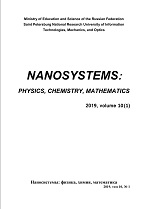|
Эта публикация цитируется в 1 научной статье (всего в 1 статье)
CHEMISTRY AND MATERIAL SCIENCE
Approaches to determining the kinetics for the formation of a nano-dispersed substance from the experimental distribution functions of its nanoparticle properties
S. Z. Adzhieva, I. V. Melikhova, V. V. Vedenyapinbc
a Lomonosov Moscow State University, Moscow, Russia
b Keldysh Institute of Applied Mathematics of Russian Academy of Sciences
c RUDN-University, Moscow, Russia
Аннотация:
In the present paper, we discuss the kinetic equations for the evolution of particles of a nanodispersed substance, distinguishing by properties (sizes, velocities, positions, etc.). The aim of the present investigation is to determine the coefficients for the equations by the distribution functions, which are obtained experimentally. The experiment is characterized by the time interval, which is needed for the measurement of the distribution function. However, the nanodispersed substance is obtained from a highly supersaturated solution or vapor and this time interval is large, thus, one is able to measure distribution functions only when the processes of the integration and the fragmentation of the particles become rather slow. So it is advisable to reconstruct the kinetics for the formation of a nanodispersed substance by the experimental distribution functions measured when the processes are rather slow. The first problem that arises is the obtaining of correct equations, and, hence, the derivation of the equations from each other. From the discrete system of equations for the evolution of discrete distribution functions of particles of a nanodispersed substance, we obtain the continuum equation of the Fokker-Planck type, or of the Einstein–Kolmogorov type, or of the diffuse approximation on the distribution function of nanoparticles distinguishing by the numbers of molecules forming them. We consider the distribution functions, which approximate the experimental data. We determine the coefficients for the equation of the Fokker–Planck type by the stationary and non-stationary distribution functions of a nanodispersed substance. Due to unity of the kinetic approach, the present work may be useful for specialists of various areas, who study the evolution of structures (not only with nanosize) with differing properties.
Ключевые слова:
nanodispersed substance, nanoparticles, distribution function of particles by properties, emerging and growth of nanoparticles, aggregation and agglomeration, the Fokker–Planck equation, the Smoluchowski system of equations, the Becker–Döring equations.
Поступила в редакцию: 08.09.2019
Исправленный вариант: 05.10.2019
Образец цитирования:
S. Z. Adzhiev, I. V. Melikhov, V. V. Vedenyapin, “Approaches to determining the kinetics for the formation of a nano-dispersed substance from the experimental distribution functions of its nanoparticle properties”, Наносистемы: физика, химия, математика, 10:5 (2019), 549–563
Образцы ссылок на эту страницу:
https://www.mathnet.ru/rus/nano469 https://www.mathnet.ru/rus/nano/v10/i5/p549
|

|




 Обратная связь:
Обратная связь: Пользовательское соглашение
Пользовательское соглашение
 Регистрация посетителей портала
Регистрация посетителей портала Логотипы
Логотипы








 Цитирование в формате
Цитирование в формате 
